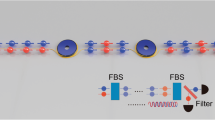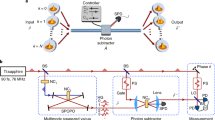Abstract
Quantum discord has been shown to be a resource for quantum advantage in addition to quantum entanglement. While many experiments have demonstrated classical analogies of entanglement, none have done so for discord. We present a proof-of-concept demonstration for creating a classical analogue of quantum discord using classical light that takes advantage of the analogy between the state of two qubits and the spatial modes of a Laguerre-Gauss beam. We demonstrate the validity of this approach by comparing the intensity profiles of theoretical simulations to experimental results for different values of discord. Such a classical analogue of quantum discord may provide further insight in understanding and development of quantum information technologies that make use of discord.




Similar content being viewed by others
Data Availability
Data underlying the results presented in this paper are not publicly available at this time but may be obtained from the authors upon reasonable request.
Change history
10 October 2023
A Correction to this paper has been published: https://doi.org/10.1140/epjs/s11734-023-00999-y
References
F. Arute, K. Arya, R. Babbush, D. Bacon, J. Bardin, R. Barends, R. Biswas, S. Boixo, F. Brandao, D. Buell, B. Burkett, Y. Chen, Z. Chen, B. Chiaro, R. Collins, W. Courtney, A. Dunsworth, E. Farhi, B. Foxen, J. Martinis, Quantum supremacy using a programmable superconducting processor. Nature 574, 505–510 (2019). https://doi.org/10.1038/s41586-019-1666-5
C.H. Bennett, G. Brassard, Quantum cryptography: public key distribution and coin tossing. Proc. IEEE Int. Conf. Comput. Syst. Signal Process. 175, 8 (1984)
C.H. Bennett, F. Bessette, L. Brassard, Gilles, J. Salvail, Smolin, Experimental quantum cryptography. J. Cryptol. (1992). https://doi.org/10.1007/BF00191318
R.C. Pooser, N. Savino, E. Batson, J.L. Beckey, J. Garcia, B.J. Lawrie, Truncated nonlinear interferometry for quantum-enhanced atomic force microscopy. Phys. Rev. Lett. 124, 230504 (2020). https://doi.org/10.1103/PhysRevLett.124.230504
V. Giovannetti, S. Lloyd, L. Maccone, Quantum-enhanced measurements: beating the standard quantum limit. Science (New York, N.Y.) 306, 1330–6 (2004). https://doi.org/10.1126/science.1104149
F. Hudelist, J. Kong, C. Liu, J. **g, Z.Y. Ou, W. Zhang, Quantum metrology with parametric amplifier-based photon correlation interferometers. Nat. Commun. 5, 3049 (2014). https://doi.org/10.1038/ncomms4049
Y. Ma, H. Miao, B. Pang, M. Evans, C. Zhao, J. Harms, R. Schnabel, Y. Chen, Proposal for gravitational-wave detection beyond the standard quantum limit via epr entanglement. Nat. Phys. (2016). https://doi.org/10.1038/nphys4118
R.P. Feynman, Simulating physics with computers. Int. J. Theor. Phys. 21(6), 467–488 (1982)
E. Knill, R. Laflamme, Power of one bit of quantum information. Phys. Rev. Lett. 81(25), 5672–5675 (1998). https://doi.org/10.1103/PhysRevLett.81.5672
A. Datta, A. Shaji, C.M. Caves, Quantum discord and the power of one qubit. Phys. Rev. Lett. 100(5), 050502 (2008). https://doi.org/10.1103/PhysRevLett.100.050502
B.P. Lanyon, M. Barbieri, M.P. Almeida, A.G. White, Experimental quantum computing without entanglement. Phys. Rev. Lett. 101, 200501 (2008). https://doi.org/10.1103/PhysRevLett.101.200501
L. Chen, Quantum discord of thermal two-photon orbital angular momentum state: mimicking teleportation to transmit an image. Light: Sci. Appl. 10(1), 148 (2021). https://doi.org/10.1038/s41377-021-00585-8. (Accessed 2022-04-18)
H. Ollivier, W.H. Zurek, Quantum discord: a measure of the quantumness of correlations. Phys. Rev. Lett. 88(1), 017901 (2001). https://doi.org/10.1103/PhysRevLett.88.017901. (Accessed 2021-07-22)
S. Luo, Quantum discord for two-qubit systems. Phys. Rev. A 77(4), 042303 (2008). https://doi.org/10.1103/PhysRevA.77.042303. (Accessed 2021-09-21)
V. Chille, N. Quinn, C. Peuntinger, C. Croal, L. Mišta, C. Marquardt, G. Leuchs, N. Korolkova, Quantum nature of gaussian discord: experimental evidence and role of system-environment correlations. Phys. Rev. A 91, 050301 (2015). https://doi.org/10.1103/PhysRevA.91.050301
P.A.M. Dirac, On the analogy between classical and quantum mechanics. Rev. Mod. Phys. 17, 195–199 (1945). https://doi.org/10.1103/RevModPhys.17.195
A. Enders, G. Nimtz, Evanescent-mode propagation and quantum tunneling. Phys. Rev. E 48, 632–634 (1993). https://doi.org/10.1103/PhysRevE.48.632
J.J. Hupert, Evanescent fields in physics and their interpretations in terms of flowgraphs. Appl. Phys. 6(2), 131–149 (1975). https://doi.org/10.1007/BF00883744
X.-F. Qian, B. Little, J.C. Howell, J.H. Eberly, Shifting the quantum-classical boundary: theory and experiment for statistically classical optical fields. Optica 2(7), 611–615 (2015). https://doi.org/10.1364/OPTICA.2.000611. (Publisher: Optical Society of America. Accessed 2022-01-20)
D. Dragoman, M. Dragoman, Quantum-classical analogies. The frontiers collection (Springer, Berlin, 2004). https://doi.org/10.1007/978-3-662-09647-5_1
J.H. Eberly, X.-F. Qian, A.A. Qasimi, H. Ali, M.A. Alonso, R. Gutiérrez-Cuevas, B.J. Little, J.C. Howell, T. Malhotra, A.N. Vamivakas, Quantum and classical optics-emerging links. Physica Scripta 91(6), 063003 (2016). https://doi.org/10.1088/0031-8949/91/6/063003. (Publisher: IOP Publishing. Accessed 2022-01-20)
N. Korolkova, G. Leuchs, Quantum correlations in separable multi-mode states and in classically entangled light. Reports Progress Phys. 82(5), 056001 (2019). https://doi.org/10.1088/1361-6633/ab0c6b. (Accessed 2021-11-22)
C. Tzanakis, Discovering by analogy: the case of Schrödinger’s equation. Eur. J. Phys. 19(1), 69–75 (1998). https://doi.org/10.1088/0143-0807/19/1/010. (Accessed 2021-04-15)
S. Liu, S. Liu, C. Yang, Z. Xu, Y. Li, Y. Li, Z. Zhou, G. Guo, B. Shi, Classical simulation of high-dimensional entanglement by non-separable angular and radial modes. Opt. Express 27(13), 18363–18375 (2019). https://doi.org/10.1364/OE.27.018363
C.V.S. Borges, M. Hor-Meyll, J.A.O. Huguenin, A.Z. Khoury, Bell-like inequality for the spin-orbit separability of a laser beam. Phys. Rev. A 82, 033833 (2010). https://doi.org/10.1103/PhysRevA.82.033833
X.-F. Qian, J.H. Eberly, Entanglement and classical polarization states. Opt. Lett. 36(20), 4110–4112 (2011). https://doi.org/10.1364/OL.36.004110. (Publisher: Optical Society of America. Accessed 2022-01-20)
R.J.C. Spreeuw, A classical analogy of entanglement. Found. Phys. 28(3), 361–374 (1998). https://doi.org/10.1023/A:1018703709245
M. McLaren, M. Agnew, J. Leach, F.S. Roux, M.J. Padgett, R.W. Boyd, A. Forbes, Entangled Bessel-Gaussian beams. Opt. Express 20(21), 23589–23597 (2012). https://doi.org/10.1364/OE.20.023589
A. Aiello, F. Töppel, C. Marquardt, E. Giacobino, G. Leuchs, Quantum-like nonseparable structures in optical beams. New J. Phys. 17(4), 043024 (2015). https://doi.org/10.1088/1367-2630/17/4/043024
M. McLaren, T. Konrad, A. Forbes, Measuring the nonseparability of vector vortex beams. Phys. Rev. A 92(2), 023833 (2015). https://doi.org/10.1103/PhysRevA.92.023833
C.E.R. Souza, J.A.O. Huguenin, P. Milman, A.Z. Khoury, Topological phase for spin-orbit transformations on a laser beam. Phys. Rev. Lett. 99, 160401 (2007). https://doi.org/10.1103/PhysRevLett.99.160401
K.F. Lee, J.E. Thomas, Experimental simulation of two-particle quantum entanglement using classical fields. Phys. Rev. Lett. 88, 097902 (2002). https://doi.org/10.1103/PhysRevLett.88.097902
T. Konrad, A. Forbes, Quantum mechanics and classical light. Contemp. Phys. 60(1), 1–22 (2019). https://doi.org/10.1080/00107514.2019.1580433
Y. Sun, X. Song, H. Qin, X. Zhang, Z. Yang, X. Zhang, Non-local classical optical correlation and implementing analogy of quantum teleportation. Sci. Reports 5, 9175 (2015). https://doi.org/10.1038/srep09175. (Accessed 2021-07-16)
B. Stoklasa, L. Motka, J. Rehacek, Z. Hradil, L.L. Sánchez-Soto, G.S. Agarwal, Experimental violation of a bell-like inequality with optical vortex beams. New J. Phys. 17(11), 113046 (2015). https://doi.org/10.1088/1367-2630/17/11/113046
S.K. Goyal, F.S. Roux, A. Forbes, T. Konrad, Implementing quantum walks using orbital angular momentum of classical light. Phys. Rev. Lett. 110, 263602 (2013). https://doi.org/10.1103/PhysRevLett.110.263602
F. Cardano, F. Massa, H. Qassim, E. Karimi, S. Slussarenko, D. Paparo, C. Lisio, F. Sciarrino, E. Santamato, R.W. Boyd, L. Marrucci, Quantum walks and wavepacket dynamics on a lattice with twisted photons. Sci. Adv. 1(2), 1500087 (2015). https://doi.org/10.1126/sciadv.1500087
A.N. Oliveira, S.P. Walborn, C.H. Monken, Implementing the Deutsch algorithm with polarization and transverse spatial modes. J. Opt. B: Quantum Semiclass. Opt. 7(9), 288 (2005). https://doi.org/10.1088/1464-4266/7/9/009
B. Perez-Garcia, R.I. Hernandez-Aranda, A. Forbes, T. Konrad, The first iteration of Grover’s algorithm using classical light with orbital angular momentum. J. Mod. Opt. 65(16), 1942–1948 (2018). https://doi.org/10.1080/09500340.2018.1459910
Z.-L. Zhou, H. Yuan, L.-F. Wei, Entanglement, quantum discord, and non-locality in bell-diagonal states. Int. J. Theor. Phys. 52(2), 420–428 (2013). https://doi.org/10.1007/s10773-012-1348-7. (Accessed 2021-07-19)
L. Henderson, V. Vedral, Classical, quantum and total correlations. J. Phys. A: Math. Gen. 34(35), 6899–6905 (2001). https://doi.org/10.1088/0305-4470/34/35/315
J.H. Eberly, Correlation, coherence and context. Laser Phys. 26(8), 084004 (2016). https://doi.org/10.1088/1054-660X/26/8/084004
E. Wolf, Introduction to the Theory of Coherence and Polarization of Light (Cambridge University Press, New York, 2007)
G. Goubau, F. Schwering, On the guided propagation of electromagnetic wave beams. IRE Trans. Antennas Propag. 9(3), 248–256 (1961). https://doi.org/10.1109/TAP.1961.1144999
D. Barberena, G. Gatti, F.D. Zela, Experimental demonstration of a secondary source of partially polarized states. J. Opt. Soc. Am. A 32(4), 697–700 (2015). https://doi.org/10.1364/JOSAA.32.000697
F.S. Roux, Y. Zhang, Projective measurements in quantum and classical optical systems. Phys. Rev. A 90, 033835 (2014). https://doi.org/10.1103/PhysRevA.90.033835
S. Pirandola, Quantum discord as a resource for quantum cryptography. Sci. Rep. 4(1), 6956 (2014). https://doi.org/10.1038/srep06956
R. Ghobadi, J.S. Oberoi, E. Zahedinejhad, The power of one qubit in machine learning. ar**v:1905.01390 [quant-ph] (2019). ar**v: 1905.01390. (Accessed 2022-03-21)
B. Dakić, Y.O. Lipp, X. Ma, M. Ringbauer, S. Kropatschek, S. Barz, T. Paterek, V. Vedral, A. Zeilinger, Č Brukner, P. Walther, Quantum discord as resource for remote state preparation. Nat. Phys. 8(9), 666–670 (2012). https://doi.org/10.1038/nphys2377
K. Modi, A. Brodutch, H. Cable, T. Paterek, V. Vedral, The classical-quantum boundary for correlations: discord and related measures. Rev. Mod. Phys. 84(4), 1655–1707 (2012). https://doi.org/10.1103/RevModPhys.84.1655. (Accessed 2021-07-14)
Acknowledgements
This material is based upon research supported by, or in part by, the U. S. Office of Naval Research under Award Number N000141912374. This work was also supported by the Defense Advanced Research Projects Agency (DARPA) Grant Number D19AP00043 under the mentorship of Dr. Joseph Altepeter. D.I.B. is also supported by the U.S. Army Research Office (ARO) under Grant W911NF-23-1-0288. J. M. L. was supported by the Louisiana Board of Regents’ Graduate Fellowship Program. The views and conclusions contained in this document are those of the authors and should not be interpreted as representing the official policies, either expressed or implied, of DARPA, ONR, ARO, or the U.S. Government. The U.S. Government is authorized to reproduce and distribute reprints for Government purposes notwithstanding any copyright notation herein.
Funding
U. S. Office of Naval Research (N000141912374); Defense Advanced Research Projects Agency (D19AP00043); U.S. Army Research Office (W911NF-23-1-0288).
Author information
Authors and Affiliations
Corresponding author
Ethics declarations
Conflict of interest
The authors declare no conflicts of interest.
Additional information
The original online version of this article was revised: “On page 2, 3, and 4 of the pdf of this article, the term “—E)(E—” should have read “|E)(E|”. The typesetter apologizes for the mistake.
Rights and permissions
Springer Nature or its licensor (e.g. a society or other partner) holds exclusive rights to this article under a publishing agreement with the author(s) or other rightsholder(s); author self-archiving of the accepted manuscript version of this article is solely governed by the terms of such publishing agreement and applicable law.
About this article
Cite this article
Leamer, J.M., Zhang, W., Savino, N.J. et al. Classical optical analogue of quantum discord. Eur. Phys. J. Spec. Top. 232, 3345–3351 (2023). https://doi.org/10.1140/epjs/s11734-023-00988-1
Received:
Accepted:
Published:
Issue Date:
DOI: https://doi.org/10.1140/epjs/s11734-023-00988-1




